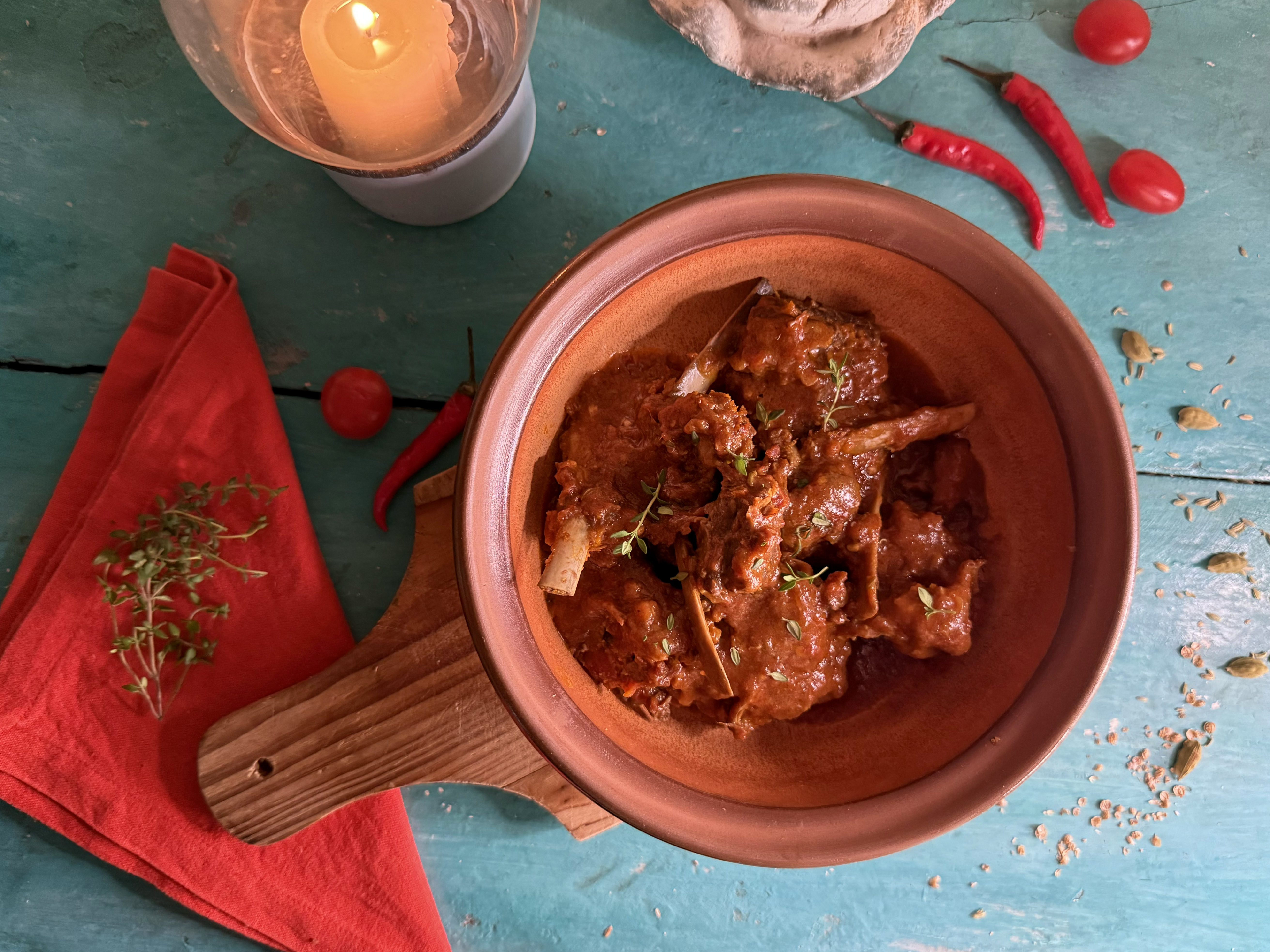There’s more to a tomato bredie than tomatoes. In fact, in addition to that fruit (yes, a tomato is a fruit), a tomato bredie is just as much about mutton. And mutton fat.
Tomato bredie is a worthy classic of South African cuisine and is not made nearly as often as it deserves to be. Given the full C Louis Leipoldt treatment, it is a fine dish that will charm the most discerning palate.
In the old Cape kitchens, tomato bredie was one of those dishes that every self-respecting cook had their recipe for, and all would swear by their version. A tomato bredie, in its essence, is a stew of fatty mutton, tomatoes and spices simmered for hours. But there’s more to it than that. If your first 21st century thought is, well, we’ll ditch the fat for starters, rather find another recipe. Fatty mutton is as much what a tomato bredie is all about as the tomatoes themselves.
So, you want mutton rib. Mutton because it’s richer in flavour than lamb, and rib because it has both bones and layers of fat. But first let’s go back a century and more...
Before writing this recipe, I delved into Renata Coetzee’s classic The South African Culinary Tradition, but found her tomato bredie recipe rather plain. In search of something more robust, I found C Louis Leipoldt’s recipe for it in Leipoldt’s Food & Wine, to discover that his version is cheese to Coetzee’s chalk. This with respect to Coetzee, whose book is a favourite of mine; but it simply sets out a basic formula for your ubiquitous tomato bredie. Hers has mutton (fatty), onion, chilli, 12 tomatoes, a little sugar, salt and pepper, and of course water. That’s it.
Tony Jackman’s weekly newsletter is packed with bright food ideas and delicious stories about food and life. Sign up to Tony’s weekly newsletter here. It’s free, and in your inbox every Friday afternoon. If it goes to promotions or spam at first, please drag it into your inbox.
But veer over to Leipoldt’s Food & Wine and the story is very different. Instead of Coetzee’s eight ingredients (if you include the salt and pepper and the water, so just five without them), Leipoldt lists 18. Then, being Leipoldt, he adds a final “glass of wine”, which frankly he seemed to put into everything. So: Leipoldt 19, Coetzee 8. No contest. Not that the quality of every dish rests on its number of individual ingredients, but in this case I have no doubt Leipoldt’s is in a higher league altogether; having made something approximating it and have it turn out so delicious that I cannot believe I hadn’t made tomato bredie in years.
My recipe does not follow his recipe to the letter, but I did use it as a guide. This recipe differs slightly from my earlier one from 2021.
Tomato bredie potjie, after the C Louis Leipoldt style
Ingredients
1kg mutton rib cut into small pieces
2 large onions, sliced
1 heaped Tbsp flour
1 Tbsp butter (optional, explained below)
3cm piece fresh ginger, peeled and chopped
10 cardamom pods
1 tsp fennel seeds
1 tsp coriander seeds
A few peppercorns, whole
3 or 4 thyme sprigs
2 or 3 marjoram sprigs (or oregano)
3 red chillies, chopped, including seeds and veins
3 x 400g cans of chopped tomatoes
4 ripe tomatoes, quartered
80g tomato paste
Salt to taste (be generous)
2 Tbsp chutney
1 Tbsp brown sugar
Method
Make a big, hot fire. When you have coals, put some around the perimeter of the legs of a potjie.
When the potjie is hot, put all the mutton rib pieces into it and add the sliced onions. Sprinkle the flour over and stir with a wooden spoon, to coat.
Throw in a heaped tablespoon of butter (unless your meat has sufficient fat), give it a stir, and let it cook for 10 to 15 minutes, to get the mutton’s own fats working to create some pleasing fattiness in the burgeoning stew.
Don’t be shy of the fat. Eventually, the fat on top of the potjie will be spooned off, but by then the fat will have given the stew a lovely luxurious depth of flavour. (Note: Leipoldt does not add butter but calls for sheep fat, also known as tallow. If you use nicely fatty mutton ribs, this process will happen in the pot and you may not need extra fat. But help it along with a little butter, as I did, if you like.)
Now start adding most of the other ingredients, but not the tomatoes or the salt: add the ginger, cardamom seeds, coriander seeds, peppercorns and fennel seeds, as well as a few sprigs of thyme (Leipoldt calls for marjoram too, if you have some, but I used oregano instead), garlic chives, and chillies. Braise everything in the potjie, stirring now and then, for 10 to 15 minutes, then add all the tomatoes, stir, and cook covered for three or more hours or until the mutton is so tender that it falls off the bone.
Only salt the stew half an hour before the end of cooking, then, once salted, also add two tablespoons of chutney and a tablespoon of brown sugar. Simmer, this time uncovered, to evaporate (to a point) and thicken, but don’t let it cook away so much that you no longer have a lovely moist, thick stew. Serve with rice. DM
Tony Jackman is Galliova Food Writer 2023, jointly with TGIFood columnist Anna Trapido.
Order Tony’s book, foodSTUFF, here.
Follow Tony Jackman on Instagram @tony_jackman_cooks.
This dish is photographed in a blue Liebermann bowl, which was a wedding gift 41 years ago and is still as good as new. ?





